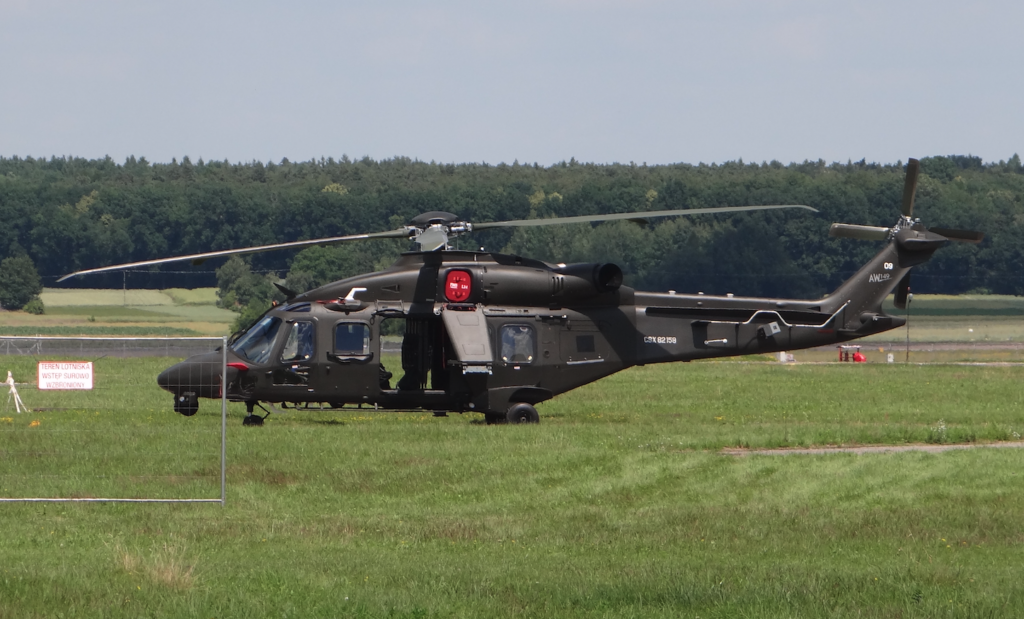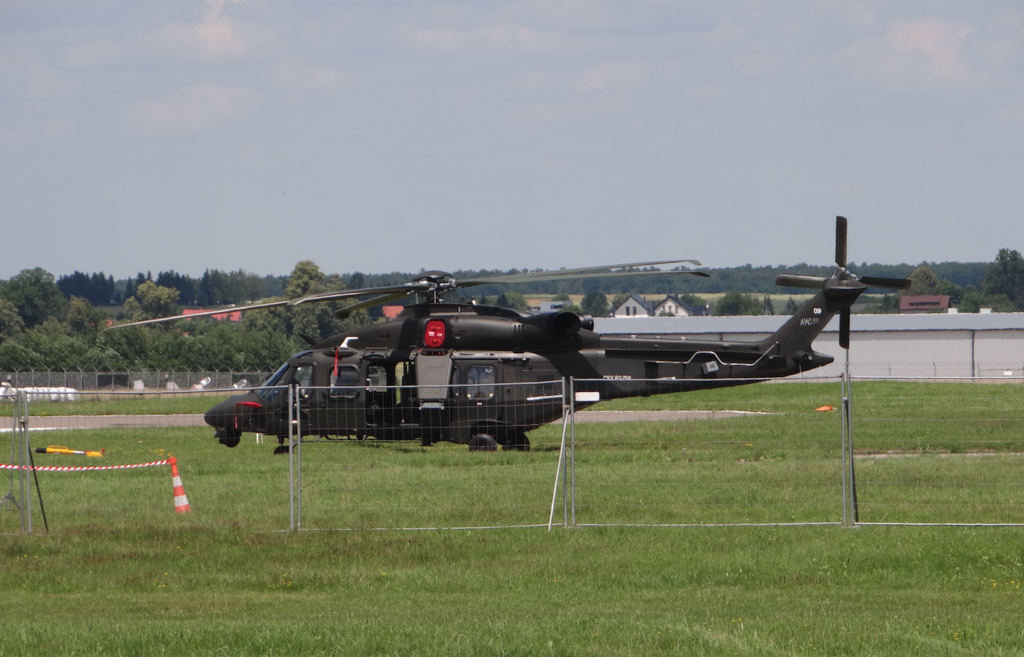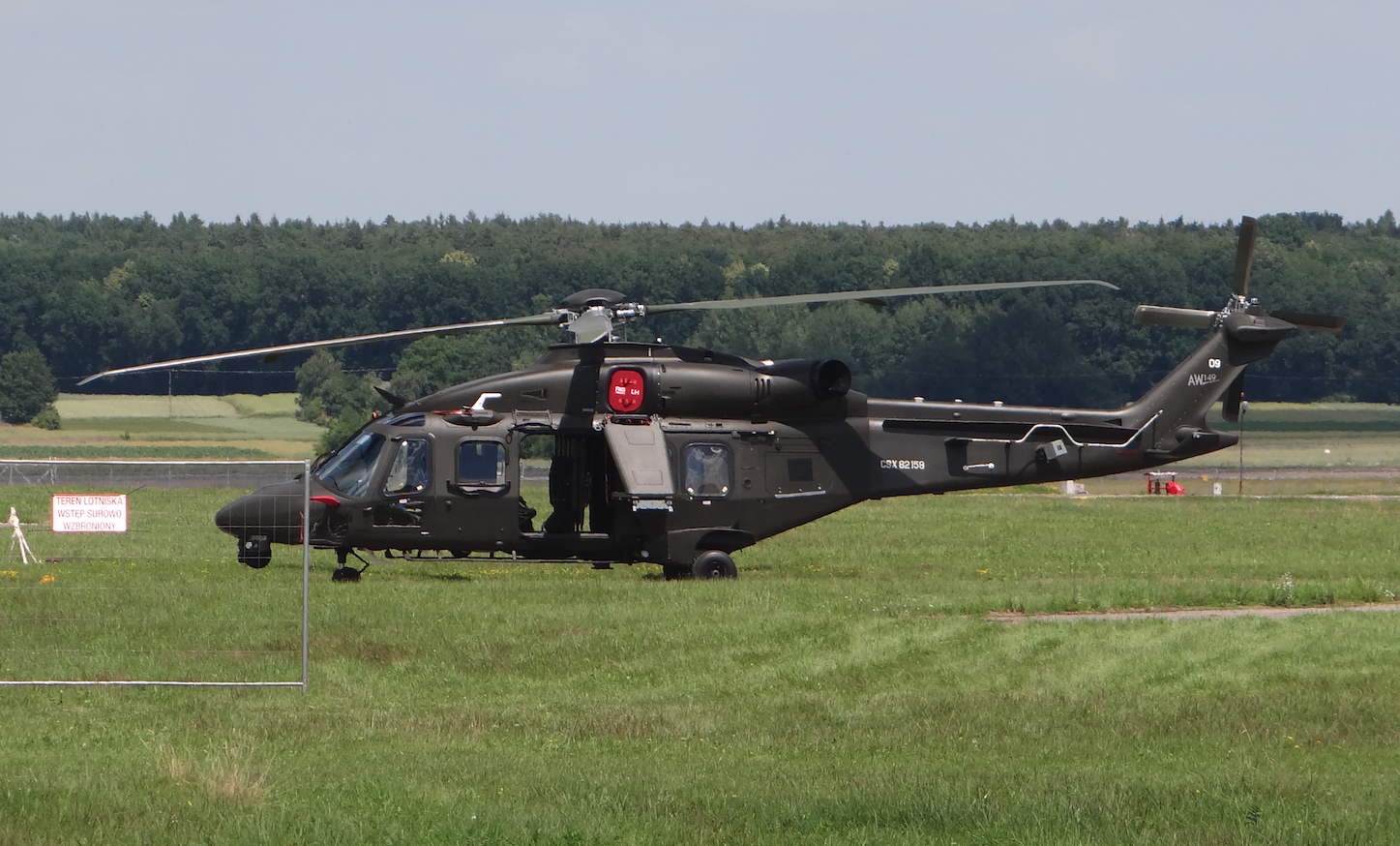Świdnik 2024-07-18
AW.149 helicopter.
The AW.149 helicopter was selected for the Polish Army as part of a programme to acquire multi-role support helicopters under the code name ‘Perkoz’. The first two helicopters have already been delivered to the soldiers of the 25th Air Cavalry Brigade in Tomaszów Mazowiecki. This is the result of a contract signed in July 2022, which includes the purchase of 32 AW.149 helicopters. The delivery of the helicopters is scheduled for the period 2023-2029.


The helicopter’s armament has been configured in accordance with the recommendations of the Polish Armed Forces. On board the helicopter are; observation systems, shooting armament, guided and unguided missiles and self-defence systems. The armament, depending on the variant of use of the helicopter, can be installed in the cargo bay or on the suspension points of the helicopter. The helicopters will perform both troop transport and sub-unit support tasks from the air. The equipment also allows the helicopters to be used for evacuation, combat search and rescue (CSAR) operations and the transport of goods and supplies. The contract provides for the delivery of 32 AW149 helicopters along with a logistics package, spare parts and consumables. A flight simulator will also be supplied. The value of the contract is PLN 8 billion 250 million.
Let us remember that the AW.149 helicopters will be serviced at the Świdnik plant. The PZL-Świdnik plant manufactures elements of helicopters from the Leonardo Group, such as the AW.189 commercial helicopter. At present, 2024, 550 engineers work at PZL-Świdnik and participate in many programmes carried out by the concern. The first military unit to take on AW.149 helicopters is the 25th Air Cavalry Brigade in Tomaszów Mazowiecki. The first training courses for pilots and technicians were conducted at the Leonardo plant. In January 2024, two AW.149 helicopters were already on the brigade’s equipment in Tomaszów Mazowiecki. The next ones will be delivered according to the chronogram.
There is no doubt that the Polish Army will need more helicopters. After Comrade-Car Putin starts another war, in 2022, the Polish Army will need a minimum of 64 more combat helicopters. The problem is that in 2023-2024, the ‘Coalition of 13 December’ came to power in Poland and the cuts to the budget of the Ministry of Defence began.
PZL-Świdnik is able to increase the rate of production of helicopter components, depending on the requirements of the Ministry of Defence. The PZL-Świdnik plant has been ready to launch up to two helicopter production lines from the very beginning of its operation in the Leonardo group.
Advantages of the AW.149 helicopter.
The AW.149 helicopter has an extensive, state-of-the-art anti-icing system. This system is based on a set of sensors and heating elements that are connected to a computer. In automatic mode, the system controls and continuously monitors the condition not only of the blades, but of all key helicopter components. The system is designed to react appropriately on its own or to tell the pilots what to do. The helicopter, which was ordered by the Polish Armed Forces, can operate in temperatures from +50 to -40 degrees Celsius, and the solution used here by the Polish Army is used, among others, in the North Sea region, where it meets very strict climatic requirements.
The AW.149’s self-defence and radio-electronic warfare systems are some of the helicopter’s most important systems. The manufacturer and the Ministry of Defence do not release much information about the operation of this system. All because the Masonic media are looking for sensationalism, not information. They do not care about the development of the Polish Army and strengthening Poland’s security.
Many people forget under what conditions the contract was signed. The contract for the supply of AW.149 helicopters was signed on 1 July 2022, i.e. a few months after Moscow’s aggression against Ukraine, when the geopolitical situation was unpredictable, in addition with a negative trend. Therefore, the Polish Army decided to go for a helicopter larger than the one that had been previously considered under the announced programme codenamed ‘Perkoz’. The Polish Army urgently needed a helicopter with even greater capabilities and much more powerful armament. It should be added that there were no plans to install guided missile armament beforehand. Such missile armament was available in Mi-24 helicopters. But for many years now, guided missiles have not been available any more, because their stock has run out.
The Masonic media also raised the issue – no air conditioning on board the helicopter (?). All this in a situation where we have a war on our eastern border and are a frontline country. Not only that; Poland’s initial good relations with the Ukrainian government, have been circumvented with the following months. Ukraine is unable to oust the aggressor from its territory, while at the same time its citizens buy the most new BMW and AUDI cars in the world. Corruption is rampant and there is a price tag on buying one’s way out of military service. Hundreds of young Ukrainians in Poland, for example, have fun barbecuing in Krakow on the Zakrzówek reservoir, in the former quarry of the SOLVAY factory. From a practical point of view, it must be written that landing and attack helicopters in flight, often operate with their side doors open and do not require air conditioning, especially in our climate. This is an item on the equipment list for VIP helicopters.
At the moment, we do not know what the fate of the further purchase of AW.149 helicopters will be. The problem is that at the turn of 2023-2024, the ‘Coalition of 13 December’ came to power in Poland and many armament programmes may not be realised because there were cuts in the budget of the Ministry of Defence.
Data T-T AW.149:
Overall length 17.57 m. Fuselage length 14.60 m. Fuselage width 3.02 m, Height 5.14 m. Carrier rotor diameter 14.60 m. Take-off weight 8,600 kg. Maximum speed 313 km/h. Cruising speed 278 km/h. Climbing speed 9.9 m/s. Practical ceiling 15,000 ft. Hovering ceiling with ground influence 1,830 m. Range 500 nmi (926 km). Flight duration 4 hours 55 minutes.
Written by Karol Placha Hetman

